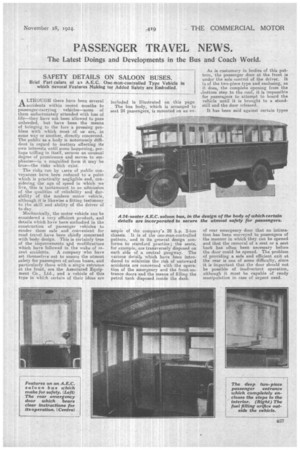PASSENGER TRAVEL NEWS.
Page 21

Page 22

If you've noticed an error in this article please click here to report it so we can fix it.
The Latest Doings and Developments in the Bus and Coach World.
SAFETY DETAILS ON SALOON BUSES.
Brief Part culars of an A.E.C. One-man-controlled Type Vehicle in which Several Features Making for Added Safety are Embodied.
ALTHOUGH there have been several accidents within recent months to passenger-carrying vehicles—some of them unfortunately attended with loss of life—they have not been allowed to pass unheeded, but have been the means of bringing to the fore a pressing prnblem with r which most of us are, in some way or another, directly concerned. The public as a body is notoriously diffident in regard to matters affecting its own interests until some happening, perhaps trifling in itself, secures an unusual degree of prominence and serves to emphasize—in a magnified form it may be true—the risks which exist.
The risks run by Leers of public conveyances have hen reduced to a point which is pi-actically negligible and, considering the age of speed in which we live, this is tantamount to an admission of the qualities of reliability and durability of the modern motor vehicle, although it is likewise a fitting testimony to the skill and ability of the driver Of to-day
Mechanically, the motor vehicle can be considered a very efficient product, and details which have been embodied in the construction of passenger vehicles to render them safe and convenient for road travel have been chiefly concerned with body design. This is certainly true of the improvements a,nd modifications which have followed in the wake of recent accidents. A company who have set themselves out to ensure the utmost safety for passengers of saloon buses, and particularly those with a single entrance at the front, are the Associated Equipment Co., Ltd., and a vehicle of this type in which certain of their ideas are
included is illustrated on this page. . The bus body, which is arranged to seat 24 passengers, is mounted on an ex ample of the company's 28 hp. 2-ton chassis. It is of the one-roan-controlled pattern, and in its general design conforms to standard. practice; the seats, for example, are transversely disposed on each side of a central gangway. The various details which have been introduced to minimize the risk of untoward accidents are concerned with tbe operation of the emergency and the front-em. trance doors and the means of filling the petrol tank disposed inside the dash. As is customary in bodies of this pattern, the passenger door at the front is under the sole control of the driver. It is of the two-piece type and enclosing, as it does, the complete opening from the ...bottom step to the roof, it is impossible for passengers to attempt to board the vehicle until it is brought to a standstill and the door released.
It has been said against certain types of rear emergency door that no intimation has been conveyed to passengers of the manner in which they can be opened and that the removal of a seat or a seat back has often been necessary before the door could be opened. The problem of providing a safe and efficient exit at the rear is one of some difficulty, since it is important that the door should not be possible of inadvertent operation, although it must be capable of ready manipulation in case of urgent need.
We think that these factors have been satisfactorily met in the A.E.C. saloon bus. In the first place, the door is unobstructed (there is a wide gangway running the length of the body), and in the second it is fitted with a simple device taking the form of an oval plate at the end of the door-operating lever ; this has clearly painted on it the word and a bold arrow which indicates in an unmistakable manner the direction in which the handle operates. An ordinary drop-down bolt at the top. steadies the door when it is closed. This door is, of course made to open outwards.
Carelessness in the filling of fuel tanks from the interior in the presence of a naked light has been held to be responsible for serious fires on enclosed pas senger-carrying vehicles, and to overcome any risk in this direction on the A.E.C. bus the filling orifice is located in an accessible position ahead of the windscreen, fuel being led to the tank by way of a slightly inclined connection.
Electric lighting is employed throughout this vehicle, a 12-volt lighting Fset being included in the initial price of the chassis. The complete vehicle is offered at an attractive figure.
We should mention in closing that the bodywork on this A.E.C. bus was carried out by Messrs. Strachan and Brown, of Wales Farm Road, London, W 1, who have had considerable experience in the manufacture of passenger vehicle bodies of all types.
































